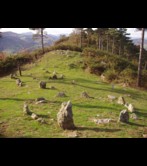Settlement during the iron age
Walled settlements
The big Neolithic revolution was the domestication of animals and plants. Thanks to agriculture and livestock farming, the activities associated with the nomadic life - hunting, collecting fruit, mushrooms, berries, herbs and roots, fish and shellfish – which were previously the basis of survival, became complementary. Ceramic production and the smelting of metals such as copper and bronze created a new way of living. In the first millennium before Christ the Celts introduced iron.
In this moment, the first walled settlements appeared, on high ground, easy to defend and from which the surrounding territory was controlled. Eight walled settlements - castros- have been found in the interior of Gipuzkoa, of varying sizes and importance, four of them lined along the Oria valley (see the interactive map), in other words, along one of the main routes between western Europe and the Iberian Peninsula. The remains that have been discovered (Celto-Iberian ceramics, and Central European style jewellery) confirm that trade was carried out over large distances (see photo gallery within the interactive map).
Iron Age dwellings
The existence within the settlements of houses of some 60 m² with spaces separating people from animals and food stocks, the use of a variety of materials and with access to water nearby – from a stream or rainwater – leads us to think that they had achieved a certain level of comfort.
Archaeological dig of the Munoaundi camp
Cultures coexisting
In spite of the importance that some of the settlements would later have, no trace of Roman influence has been discovered, suggesting that these settlements were gradually abandoned and that their inhabitants moved to the valley floors and towards the coast before the Roman armies finally conquered the peninsula after the Cantabrian wars (29 - 19 BC).
Archaeological research over the past 20 years has revealed the coexistence of this culture of living in forts, known as Castros, with another culture which created stone circles, known as cromlechs, associated with death (see cromlech area within the interactive map). In principle they are not incompatible, given that some remains refer to life and others to death, but they do not coincide geographically, that is to say, forts are not found in the same place as cromlechs (although neither have the remains of those who built them been found) and cromlechs are not found in the forts, (even in those where funeral remains have been found) suggesting that they were two neighbouring but different cultures. The cromlech area stops suddenly in the Leitzaran valley in Andoain, spreading from there and the foothills of the Pyrenees in the direction of Andorra, suggesting they were a group of people distinct from the Vascons (the ancient inhabitants of Navarra). The fortified villages, on the other hand, border the strip in which cromlechs are found, as much in Gipuzkoa, (Buruntza and Andoain) as in Lapurdi, Lower Navarra and to the north of the Pyrenees.





